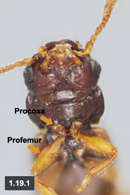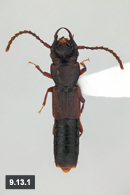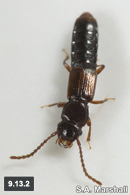
| Piestinae Erichson 1839: Siagonium Kirby and Spence 1815 |
||||||||
 |
||||||||
| Figure 1.19.1 Phloeocharinae: Charhyphus picipennis LeConte, anterioventral view of procoxae. 1.20.2 Siagonium punctatum (LeConte), left protibia. 9.13.1 S. punctatum, major male, dorsal habitus. 9.13.2 S. punctatum, minor male from under beech bark. | ||||||||
|
||||||||
 |
||||||||
Siagonium can be recognized by the small, globular procoxae (Fig. 1.19.1), protibia with thick spines (Fig. 1.20.2) and the hornlike projections in front of the eyes in males (Fig. 9.13.1, major male; 9.13.2, minor male). The genus Olisthaerus DeJean is loosely similar in appearance but lacks the rows of coarse punctures on the elytra and does not possess cephalic horns in either sex. |
||||||||
 |
||||||||
The subfamily Piestinae is widely distributed in North America and represented in ECAS by three species of Siagonium. Very little is known about the biology of this group. All species occur under the bark of dead trees, especially conifers, and are sometimes collected at lights. Siagonium stacesmithi Hatch appears to be trans-boreal in distribution and one individual was captured in a 'northern' boreal forest consisting of mature black spruce trees (Paquin and Duperre 2001). Siagonium americanum (Melsheimer) and the more common S. punctatum (LeConte) are found in a greater variety of forest types, with the latter species extending into Mexico. Although the exact diet of Siagonium has never been experimentally determined, its mandibles and maxillae bear striking similarity to those of the mycophagous silvanid beetle Dendrophagus crenatus (Paykull) and gut contents were found to contain fungal fragments(Crowson and Ellis 1969). The mandibles of Siagonium and other Piestinae also possess invaginations, similar to the fungal spore-transmitting mycangia of scotyline and cucujoid beetles (Crowson and Ellis 1969). |
||||||||




